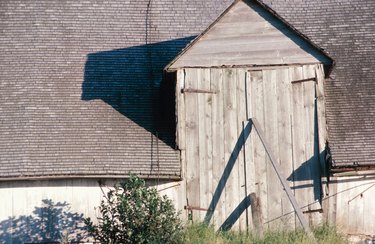
Uneven roofs are always cause for concern; bulging or sagging roof coverings indicate damage to at least one portion of the roof structure. However, there's no reason to panic, because an uneven roof doesn't necessarily mean that you have serious structural damage. For example, if damaged shingles are the cause of your uneven roof, then you might only face a small, relatively inexpensive repair job. If you see buckling or low spots, it's important to inspect your roof right away; most roof problems only worsen with time.
Insufficient Framing
Video of the Day
Rafters or joists are the primary supportive members of roof structures. Architects, engineers and designers carefully calculate framing member size, spacing and layout according to project-specific factors. If your roof is uneven, it's possible that an architect, engineer or builder didn't properly design the roof's framing structure. For example, many roof frames sag because designers failed to specify collar ties or builders failed to install them. Collar ties are beams that span between adjacent rafters and strengthen the roof against outward thrust.
Video of the Day
Damaged Framing
Damaged framing frequently causes roofs to sag or dip. Damage that causes an uneven roof might result from an acute impact, such as a fallen tree, or unexpected loads, such as unusually heavy snow. Pests and moisture are common causes of damage to roof structures. Persistent leaks and wood-boring pests, such as termites, accelerate wooden framing members' deterioration, often causing them to bend or break. Whether your damaged framing requires replacing or just mending depends on the severity of the deterioration or structural damage.
Damaged Sheathing
The first sign of moisture damage to roof sheathing is bulging. Chronic exposure to moisture damages the glue that binds plywood or oriented strand-board sheathing, which causes the wood plies or fibers to separate from adhesives or absorb moisture and swell. Eventually, water damaged sheathing will rot and cause portions of the roof to sag or completely collapse. It's best to inspect sheathing for water damage from the underlying attic; walking on a weakened or rotten roof is dangerous.
Worn Roof Coverings
Worn or deteriorated roof covering materials occasionally loosen from their fasteners and lift away from the roof, which creates an uneven appearance. Exposure to wind, rain and sun further deteriorates the roof coverings, often resulting in shingles or roof panels that appear to be peeling off of the structure. You're lucky if damage is limited to roof coverings since applying new roof coverings is inexpensive compared to replacing framing and sheathing. However, if the roof covering material's fasteners are rotten or loose, you should inspect the sheathing and framing to ensure that moisture hasn't penetrated beyond the roof's top layer.